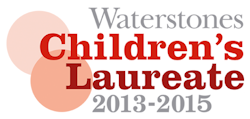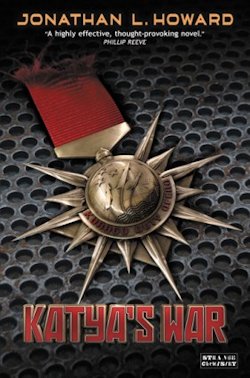Welcome back to the British Genre Fiction Focus, Tor.com’s weekly column dedicated to news and new releases from the United Kingdom’s thriving speculative fiction industry.
Already a familiar refrain, right?
Alas, this is the last time you’ll read it, because beginning this week, things are going to be different. Only a little, admittedly: news and new releases from the United Kingdom’s thriving speculative fiction industry will still be the focus of the Focus, of course, but going forward, we’re going to be splitting the two components of the column in its current form into posts of their own.
The news will still be a weekly treat each Wednesday. The new releases, however, will be a fortnightly proposition from this point on. It’s not yet set in stone, but let’s say every second Sunday. This means that the British Genre Fiction Focus will be rather more manageable for all involved. Plus, new books will have their own spotlight to shine in; their own space for discussion and such.
Got that?
Good. Then let’s get to the new and improved news. This week, it’s YA all the way! The last Waterstones Children’s Laureate has criticised the mainstream media for turning a blind eye to new releases for younger readers, whilst the latest Laureate outlines her plans for the future of literature for littles. In Cover Art Corner, we consider Katya’s War, and finally, an article from the Guardian examines gender segregation by way of the colours of the covers of the books our wee ones are taught to want.
Out with the Old
On the last day of her two year tenure, the outgoing Waterstones Children’s Laureate, Julia Donaldson, signed off with a polite but piercing poke at the media for turning a blind eye to what I’m going to call books for bairns, but only because I can’t resist a little alliteration.
Writing in the Telegraph, she made a compelling case:
Like every children’s writer, I was delighted that the opening ceremony of the Olympic Games celebrated “the glories and magic” of children’s literature. After all, our nation excels at it: we produced The Jungle Book, The Wind in the Willows, Alice in Wonderland, The Railway Children, Winnie the Pooh, Just William, Narnia, Lord of the Rings, Charlie and the Chocolate Factory, The Northern Lights, Dogger, The Tiger Who Came to Tea… I had better stop there for fear of exceeding my word count, but those are just the tip of the iceberg.
Yet on any other day of the year, a foreigner reading our newspapers, listening to our radio or watching our television, could be forgiven for getting the impression that we have little pride or interest in our children’s writers and illustrators. How could they guess that children’s books account for nearly one in four of all book sales, when far less than a fortieth of review space in printed papers is dedicated to them? Perhaps they might imagine that we have a dearth of parents, grandparents and teachers when they listen to “A Good Read” on Radio 4: of the 48 titles the programme has featured since that memorable day last July, just one is a children’s book, namely the ubiquitous US export, The Hunger Games.
Of course, kids don’t tend to read many newspapers, or listen to BBC Radio 4 all that often. But by and large, as Donaldson points out, they don’t buy their own books either.
It is largely parents who buy books for their children, and if they live in an area with no bookshop or library, which is sadly increasingly common, they would surely welcome some enthusiasm and guidance from the media. I would like it if a programme such as Radio 4’s Woman’s Hour could once a month have a Book Doctor slot, where parents or teachers could ask questions like “Why doesn’t my teenage son read any more?” or “Are there any good books about spiders?” and a panel including a children’s writer could respond.
It’s not that we don’t have any good reviewers or experts on children’s books. We have some excellent ones, and I imagine they are all chafing at the bit for more space. But often all they are asked to supply is an occasional “round-up” of children’s books, usually at Easter or Christmas. They therefore have to cram in as many titles as possible, sometimes just giving a basic plot summary, and this doesn’t make for very exciting reading.
I’m with Donaldson all the way, almost. Indubitably, it’s true that there isn’t nearly enough coverage of kid lit in the mainstream media, and the former Laureate does a good job of reminding us why there really should be.
But though it’s fair to say these books aren’t give their due in various, very visible venues, as with speculative fiction, there are any number of high quality blogs and other assorted online resources entirely devoted to this particular form and genre. Parents might be less inclined to give these the time of day, but most of the little ones have already made the internet a home away from home. So.
Donaldson, however, does not acknowledge this at all, exemplifying one of the reasons why I’m pleased to see a new face take over as Waterstones Children’s Laureate.
In with the New

The day after Donaldson’s comments, the appointment of Malorie Blackman as the new Waterstones Children’s Laureate was announced. She’ll hold the prestigious position till 2015.
The author of the five-volume strong Noughts & Crosses series, which used dystopia to describe real world racism, as well as a truly incredible number of other novels, Blackman joins an illustrious list of former Children’s Laureates, including Quentin Blake, Anne Fine, Michael Morpurgo, and Jacqueline Wilson.
And man oh man, she has some interesting plans!
But first, by way of the Bookseller, here’s some of what Blackman had to say about the job:
“I am honoured to have been chosen as the eighth Children’s Laureate. A love of books has opened so many doors for me. Stories have inspired me and taught me to aspire. I’ve been a professional author for over 20 years, so I feel now is the time to give something back. I hope to instil in every child I meet my love and enthusiasm for reading and stories.”
A most noble goal. And I like the way she means to achieve it, namely by blending ideas both new and old:
“As I would never have become an author if it hadn’t been for my local library as a child, I intend to continue Julia Donaldson’s amazing, indefatigable work advocating for our nation’s public library service.”
Blackman plans to use her position to call on teachers and parents to spend at least 10 minutes per day sharing a book with their pupils and children, as well as to encourage teenagers to explore a wide range of literature, from short stories to graphic novels. The author, who started her career as a computer programmer, is also keen to focus on the role that technology plays in making literature come alive for a generation of young people who have grown up with digital.
Did you catch all that? Graphic novels! Short stories! The value of e-books, even! All these things Blackman looks to accept with open arms, roundly rooting herself in the new where her predecessors have mostly focussed on the old.
Hearty congratulations, then, to Malorie Blackman. I hope you’ll all join me in wishing her the very best of luck realising her plans in the two year period she’ll spend as the new Waterstones Children’s Laureate.
Cover Art Corner: Katya’s War
Still on the little lit tip, Strange Chemistry just revealed the cover art and blurb for the sequel to Katya’s World by Jonathan L. Howard, an “underwater wonder” which you might recall I reviewed right here on Tor.com late last year.

If the whole truth be told, I don’t read a great year of YA—not with any regularity—but the Johannes Cabal connection, and by extension the author’s involvement in the Broken Sword series, convinced me to give Katya’s World a shot, and afterwards, I was very happy I had.
According to the blurb, Katya’s War looks to pick up some time after the conclusion of the first book, and though the cover art is a little nondescript, I’ll say it looks quite nice alongside its similarly designed processor.
Here’s a short synopsis in any event:
The battle lines have been drawn. The people of Russalka turn upon one another in a ruthless and unwavering civil war even while their world sickens and the deep black ocean is stained red with their blood. As the young civilisation weakens, its vitality fuelling the opposing armies at the cost of all else, the war drums beat louder and louder.
Katya Kuriakova knows it cannot last. Both sides are exhausted—it can only be a matter of days or weeks before they finally call a truce and negotiate. But the days and weeks pass, the death toll mounts, and still the enemy will not talk.
Then a figure from the tainted past returns to make her an offer she cannot lightly refuse—a plan to stop the war. But to do it she will have to turn her back on everything she has believed in, everything she has ever fought for, to make sacrifices greater even than laying down her own life. To save Russalka, she must become its greatest enemy.
Katya’s War will be published by Strange Chemistry in the UK this very November.
Cover Blindness
You didn’t think we were done talking about the reading habits of young adults yet, did you?
Let’s do one more story, and then you can go!

I’d like to close out this week’s column with a bit about epic fantasy author Alison Croggon’s recent article for The Guardian. Published last Wednesday, the essay examines the primitive yet apparently still pervasive practice of publishing books judged to be for boys under manly, blue-coloured covers, while those perceived to be of interest to little ladies come adorned with sequins and pink things.
Ridiculous, right? Thankfully Croggon thinks so too. “What makes readers pick up young adult fiction?” she begins by asking. Her answer:
The promise of a strong story, characters with emotional depth and intelligent writing. And yet a shelf of YA books might still suggest a world in which boys and girls make their reading choices based upon their gender.
Almost from birth, readers are corralled into the pink and blue worlds of sparkle for girls and adventure for boys. But, as American YA author Libba Bray [pointed out at a recent Reading Matters panel], books have no gender — titles for young adults, she argues, should have gender neutral covers. “We have to move the needle,” she says. “If you categorise books as for boys or for girls, the message is that boys don’t need to be concerned about the female experience. And vice versa.”
Not the message we want to be sending, surely. And as another panellist pointed out:
Gendered book marketing has particular impact upon boys. Girls […] will read across gender. But boys are often self-conscious about reading books that might be considered to be “girly.”
Which rings true with me. Of the kids I work with, only a few read regularly. I wish it were otherwise, but I’ll take what I can get at this stage. Of them, in any event, I’ll occasionally spot a female pupil with what you might be inclined to call a boy’s book, but never in a million years is a boy going to be caught with his nose buried in something pink.
And Croggon goes on:
The gendering of book covers runs parallel to the explosive issue of ethnic minority protagonistsbeing replaced with white characters on book covers. The effect is to erase any takedown of stereotypes that occurs in the writing itself, and incidentally to alienate the readers who might most enjoy the books. Young Adult fiction is often at the forefront of challenging social stereotypes and taboos […] a fact that is often unreflected in its marketing.
In the case of gendered covers, the cumulative effect is to suggest that books by or for women, no matter what their content, are more trivial, more fluffy and less significant than books by or for men.
For all we go on about the hooded dudes on the covers of our fantasy sagas, this seems a markedly more detrimental practice to me.
And that’s it for the British Genre Fiction Focus this week. Well, excepting the new releases… but I assure you, they’ll be along shortly! Anyway, as ever, I invite you to continue the conversation in the comments, and please do check in again next Wednesday for another regular round-up of book news from bonnie Blighty.
Niall Alexander is an erstwhile English teacher who reads and writes about all things weird and wonderful for The Speculative Scotsman, Strange Horizons, and Tor.com, where he contributes a weekly column concerned with news and new releases in the UK called the British Genre Fiction Focus, and co-curates the Short Fiction Spotlight. On occasion he’s been seen to tweet, twoo.










“books have no gender — titles for young adults, she argues, should have gender neutral covers.”
grrr – NO. “gender neutral” usually means “male” since the same sexism that is concerned about boys being too “girly” also sees “male” as the default. So switching to “gender neutral” covers is just going to perpetuate the problem in the long run.
What we need is more variety in covers, covers that better reflect what is inside the book, and most importantly better role models for boys in terms of reading. That last includes everything from more men (especially men of color) in early learning to adult male readers being open about reading “girly” books – instead of, like Sparks does, doing everything they can to distance themselves from the girl cooties.
The Independent newspaper now seems to have a regular children’s books column and I believe The Guardian is doing the same.
But it will be quite a battle to get good coverage of children’s literature into the broadsheets given the critical disdain in which it is held. Remember Martin Amis’ claim that he would have to be ‘brain damaged’ before he could write a children’s book?